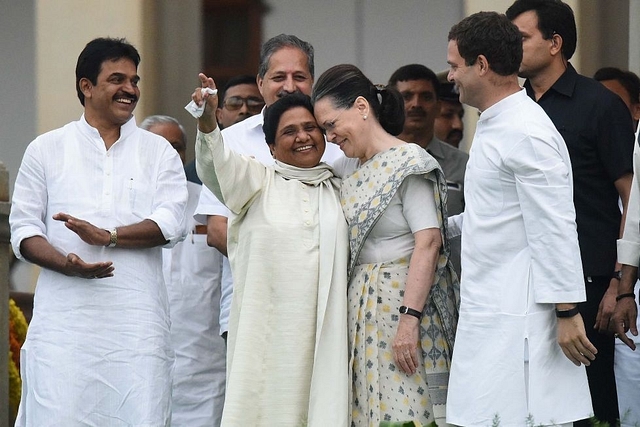
Mahagathbandhan: Grand Alliance Or Grand Scheme For Backdoor Entry Of Congress?
What is the Mahagathbandhan’s vision for India? What binds its leaders together apart from their opposition to the BJP?
“2019 will be janta vs Gathbandhan”
With that statement, Prime Minister Narendra Modi sounded the poll bugle. He has made it amply clear to the people of the two choices in front of them. A pro-reformist government with five years of work behind and a solid plan for future or a disjointed group of opportunists cobbling together for survival without any concrete vision or common ideology.
A democratic nation, which is diverse in every other way, is bound to produce groupings with varied set of ideas and vision of how the country should be. It is only in India that such diversity has not only been made peace with but is celebrated with ample pride. The broad-based society is reflected in our polity too where two big national parties exist along with number of small but significant regional players.
Therefore, coalition governments at the centre is not a completely chaotic possibility, given it fulfills two conditions. First, there is a clear vision and common ideological programme, agreed, more or less, by majority of the players.
Second, even with different regional issues, national interest holds paramount position, so much so there is zero compromise on it.
These two conditions are necessary for a coalition to survive at a national level. In case, these are not met, the coalition is bound to collapse as India had seen in the 1990s.
The Vajpayee government ticked the above two criteria and India saw its first stable coalition government in years. During his time, major decisions including the Pokhran test, formulation of India’s telecom policy, the Golden Quadrilateral were pushed.
This was followed by UPA era. Though the government of the day survived the allies’ onslaught, with the Left parties withdrawing support in opposition to the US nuclear deal, the entire period was marred with scams and policy paralysis. In that decade, Indian economy took a monumental hit with a deepening fiscal deficit at 5.6 per cent and a double-digit inflation.
The 2014 results, which gave BJP a resounding majority, were reflective of people’s frustration with a corruption-ridden coterie of opportunists and regionalists. They desired a strong leader at the helm, who is not held at ransom by varied interest groups. Narendra Modi’s ‘India First’ election slogan resonated with the masses. His focus on ‘Sabka Saath, Sabka Vikas’ was a break from the detached chorus of “what’s in it for me”. It was as if the people were asking, “What is best for the nation?”
As the ‘Mahagathbandhan’ of opposition takes shape, there is a need to analyse such an arrangement on the accounts mentioned above. With six months to the general elections, even the most diametrically opposite adversaries have joined hands together to defeat the Modi-led BJP.
However, other than the immediate short-term goal of defeating Modi, one cannot clearly pinpoint, any other ideological basis or commonality between the constituents of the Mahagathbandhan. At this juncture, the joining of hands comes as a way of survival.
Within four-and-a-half years, the entire political landscape of the country has changed. Congress for close to 70 years was considered to be the party with the natural right to power. Those born with the Nehru-Gandhi surname were put as default setting in the choice of holding one of country’s highest offices. For the first time, the fortunes of a Gandhi scion look in doldrums, as its own Mahagathbandhan partners are unwilling to declare him as the prime ministerial candidate.
Recently, the Dravida Munnetra Kazhagam chief, Stalin announced his party’s wish to see Rahul Gandhi as the prime minister of India. However, this proposal found little endorsement from Congress’s other allies, showing complete lack of confidence in Rahul Gandhi’s leadership. Under the face of solidarity, there are multiple personal ambitions simmering, which will burst open once a favourable possibility arises. Pitted against a known, performing, transparent and trusted leader, such a scenario is big risk for the country.
Secondly, the question needs to be asked whether these regional forces that are coming together would be able to set aside their regional priorities to think of the nation first? Or for that matter, would the forces fighting for their survival be able to set aside their personal ambitions to think of the nation first? The incoherent noise on GST, Rafale, farm loan waivers and surgical strikes coming from the opposition camp leave little to doubt. On matters of national importance, these parties led by the Congress have not detested from putting nation’s reputation at stake, in the pursuit of bringing Modi down.
The personal credibility of these leaders is itself in question. In fact, Congress’s two supreme leaders, Sonia and Rahul Gandhi, are themselves out on bail for case worth thousands of crores. With the AgustaWestland middleman, Christian Michel reportedly spilling the beans on Gandhis, their personal culpability in major scams would become a strong election point for the BJP to harp on.
Further, by contrasting it with Narendra Modi’s son of the soil, squeaky-clean image, the comparison between the two alternatives will become even starker.
In the first test itself, the Mahagathbandan has failed to convince the voter of its reason for existence. In Telangana, it faced a humiliating defeat with KCR coming back to power with a thumping majority. It would be now on the grouping to explain to the voter its grand alternate vision for the country that is more than just Modi baiting and actually goes beyond one-stop “solution” such as farm loan waivers to resolve long standing issues of national importance. Otherwise, it is nothing more than a way to provide back-door entry to the Congress party which has, time and again, been rejected by the people.